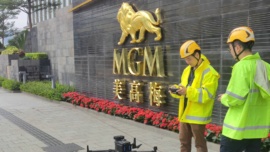“2017 was a very challenging year for CTM. Prices were reduced across the board, leased line rates were reduced by 20 to 50% at the end of 2016, mobile roaming rates declined worldwide, broadband services were also reduced, and in September IDD rates were lowered,” we can read in CTM’s 2017 Annual Report.
The most curious thing is that the 21 per cent drop in profits is not due primarily to any of the factors listed above: the reason the company’s revenue for the year ended 31 December 2017 was MOP3,585 million (MOP 4,512 million in the previous year) was “mainly due to declining mobile equipment sales, showing a decrease of 34 per cent in revenue against the previous year.”
2017 was decidedly not a good year for CTM’s accounts: “Excluding sales of mobile equipment, service revenue registered a decrease of 12 per cent in 2017. Year-on-year service revenue declines were registered in business solutions (38 per cent), Internet and data centre (12 per cent), leased circuits (7 per cent), international fixed voice (24 per cent), local fixed voice (5 per cent) and mobile (0.3 per cent).”
“These changes in prices were obviously good news to customers but had a significant effect on our business performance” – CTM’s 2017 Annual Report
Curiously, it is in the mobile market, where there is more competition in Macau, that the company fares better: the company’s mobile customer base increased by 13 per cent to 970,384 (2016: 856,735) compared to 2016, with over 863,000 4G customers. The number of mobile broadband subscribers increased by 15 per cent to 271,258 (2016: 235,742). CTM’s mobile market share is more than 40 per cent.
CTM is experiencing the problem of large telecommunications companies everywhere that had been monopolists before and now have to live with the competition – CTM is therefore feeling the pain that can continue to be felt in the coming years.
In this context it is important to remember that since 2013, when the Macau Government awarded MTel a telecommunications network licence, CTM has had a competitor.
The issue is that in five years the results of the new operator are little more than discouraging: according to information released by the company’s CEO, MTel had just over 5,000 customers in the first half of this year (4,700 individual customers and about 400 companies). The company complains that there is no “fair competition” and refers to several “obstacles” to the work of extending the company’s coverage.
Whether or not these criticisms are fair, the truth is that CTM is determined to resist the best it can.
“As of 2017, CTM had deployed fibre broadband coverage to the majority of residential units and 100% of commercial buildings. CTM’s investment coincides with the entrance of Macau’s second fixed-line operator MTel,” says the Macau Telecoms, Mobile, Broadband and Digital Media Statistics and Analyses 2017, by Business Wire. “CTM’s aggressive tactics are showing results as the majority of households are expected to be connected via fibre by 2017, closing the window of opportunity for MTel to poach subscribers from CTM’s sizeable DSL subscriber base. CTM faces another potential competitor in the Macau Cable TV operator, which is obliged to expand the reach of its underground cable network six-fold by 2017.”
That is, MTel is not yet a true competitor of CTM. But when? The truth is that the new company can only grow and have relevance at the expense of the incumbent. And that’s not good news for CTM.
5G in 2020
“We believe China and South Korea will be the first countries to implement the commercial 5G network and we think Macau can do the same at the same time,” CTM Vice-President of Network Services Declan Leong told a press conference last September.
CTM indicated that the company is in discussions with the government to obtain a 5G network licence, with CTM hoping it can obtain this in 2019.
Tests started in June and are expected to conclude in December of this year, with the technology provided by Huawei Technologies Co., Ltd.
























